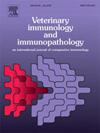Humoral and cell-mediated immune response against the Mce2B (Rv0590/Mb0605) cell-wall protein of Mycobacterium bovis
IF 1.4
3区 农林科学
Q4 IMMUNOLOGY
引用次数: 0
Abstract
Bovine tuberculosis is a zoonotic disease with global distribution. Improved diagnosis is essential thus, research into new diagnostic reagents is valuable. The Mce2B recombinant protein was evaluated as an inducer of immune response The research involved naturally infected cattle with different immunological profiles. Moderate homology (≥ 40 %) between Mce2B of M. bovis and homologous proteins in non-tuberculous mycobacteria was corroborated, as well as the presence of epitopes restricted by the bovine leucocyte antigen class II. Despite this prediction, cell-mediated responses to Mce2B were undetectable in caudal fold tuberculin skin test (CF-TST) positive and non-infected animals. In CF-TST false-negative cattle, a minimal cell-mediated response was observed (5 %; IC 95 %: 0.13–24.9), lower than that elicited by PPDB (35 %; IC 95 %: 15,4–59,2) (p = 0.046) but identical to the recombinant Fusion Protein including ESAT-6, CFP-10, EspC antigens (5 %; IC 95 %: 34.9–96.8). Marginal humoral response (33.3 %; IC 95 %: 4.3–77.7) was observed in the non-infected group. These findings demonstrate that the Mce2B protein is not a suitable antigen for bovine tuberculosis diagnosis.
牛分枝杆菌Mce2B (Rv0590/Mb0605)细胞壁蛋白的体液和细胞介导免疫应答
牛结核病是一种全球分布的人畜共患疾病。改进诊断是必要的,因此,研究新的诊断试剂是有价值的。Mce2B重组蛋白被评价为免疫反应的诱导因子。研究对象是具有不同免疫特征的自然感染牛。证实了牛分枝杆菌的Mce2B与非结核分枝杆菌的同源蛋白之间存在中度同源性(≥40 %),并且存在牛白细胞抗原II类限制的表位。尽管有这种预测,但在尾褶结核菌素皮肤试验(CF-TST)阳性和未感染的动物中未检测到细胞介导的Mce2B反应。在CF-TST假阴性的牛中,观察到最小的细胞介导反应(5 %;IC 95 %:0.13-24.9),低于PPDB(35 %;ic95 %:15,4 - 59,2)(p = 0.046),但与含有ESAT-6、CFP-10、EspC抗原的重组融合蛋白相同(5 %;IC 95 %:34.9-96.8)。边际体液反应(33.3% %;未感染组ic95 %:4.3 ~ 77.7)。这些结果表明Mce2B蛋白不是牛结核病诊断的合适抗原。
本文章由计算机程序翻译,如有差异,请以英文原文为准。
求助全文
约1分钟内获得全文
求助全文
来源期刊
CiteScore
3.40
自引率
5.60%
发文量
79
审稿时长
70 days
期刊介绍:
The journal reports basic, comparative and clinical immunology as they pertain to the animal species designated here: livestock, poultry, and fish species that are major food animals and companion animals such as cats, dogs, horses and camels, and wildlife species that act as reservoirs for food, companion or human infectious diseases, or as models for human disease.
Rodent models of infectious diseases that are of importance in the animal species indicated above,when the disease requires a level of containment that is not readily available for larger animal experimentation (ABSL3), will be considered. Papers on rabbits, lizards, guinea pigs, badgers, armadillos, elephants, antelope, and buffalo will be reviewed if the research advances our fundamental understanding of immunology, or if they act as a reservoir of infectious disease for the primary animal species designated above, or for humans. Manuscripts employing other species will be reviewed if justified as fitting into the categories above.
The following topics are appropriate: biology of cells and mechanisms of the immune system, immunochemistry, immunodeficiencies, immunodiagnosis, immunogenetics, immunopathology, immunology of infectious disease and tumors, immunoprophylaxis including vaccine development and delivery, immunological aspects of pregnancy including passive immunity, autoimmuity, neuroimmunology, and transplanatation immunology. Manuscripts that describe new genes and development of tools such as monoclonal antibodies are also of interest when part of a larger biological study. Studies employing extracts or constituents (plant extracts, feed additives or microbiome) must be sufficiently defined to be reproduced in other laboratories and also provide evidence for possible mechanisms and not simply show an effect on the immune system.

 求助内容:
求助内容: 应助结果提醒方式:
应助结果提醒方式:


